General Robert E. Lee Monument (1890-2021)
Introduction
Text-to-speech Audio
Dedicated in 1890, the former monument to Robert E. Lee that stood here was the first and largest of the monuments along Richmond’s Monument Avenue Historic District. This monument was first proposed shortly after Lee’s death in 1870. Richmond’s African American community strongly opposed erecting any monument supporting the Confederacy or its leaders, a sentiment that became more widely accepted among white residents over a century later which led to its removal in 2021. Despite voices of opposition among people who had lived through the Civil War, the project was completed in 1890. The bronze equestrian statue of Lee astride his famous horse Traveller was designed by French sculptor Jean Antoine Mercie and cast in four sections. Constructed by African American laborers, ironically enough, the General Robert E. Lee Monument was officially unveiled on May 29, 1890, to a crowd estimated to be between 100,000 and 150,000. Col Archer Anderson, a former Confederate military officer, delivered the keynote speech for this 61-foot-tall monument. Anderson contributed to the growing trend of idolizing the Confederacy and the Lost Cause ideology by praising Lee as a man of action and a hero of his home state of Virginia. During the next 30 years, five more Confederate monuments were erected along Monument Avenue, a grand, residential boulevard. Since the erection of the Robert E. Lee Monument, controversy has continued to surround the existence of Monument Avenue regarding its promotion and proliferation of racism and the Lost Cause ideology. In 2020, following nationwide protests over racism and Confederate monuments, Virginia Governor Ralph Northam ordered the monument removed. District courts upheld the governor's decision, but the decision was appealed; the Virginia Supreme Court dismissed the appeal, and the bronze statue was removed in September 2021. The graffiti-covered pedestal base also was removed later.
Images
Unveiling of the monument in 1890
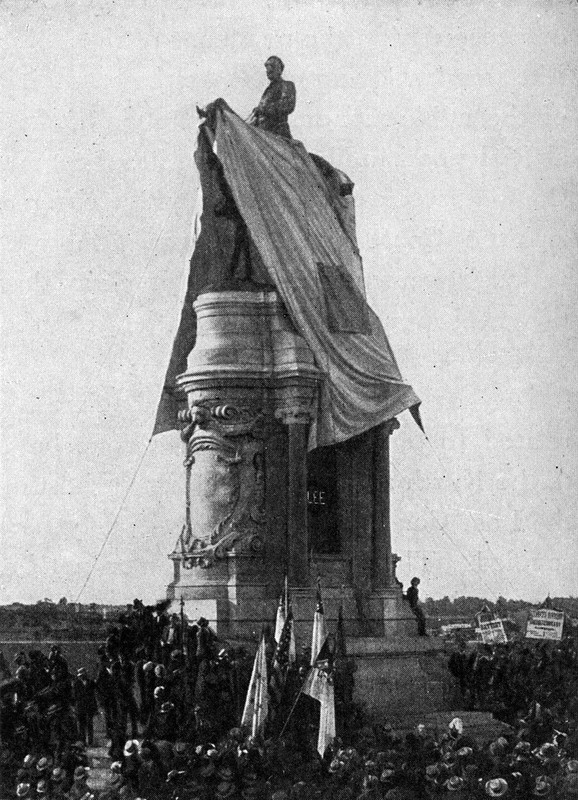
A post-unveiling image. Courtesy of the Virginia Historical Society
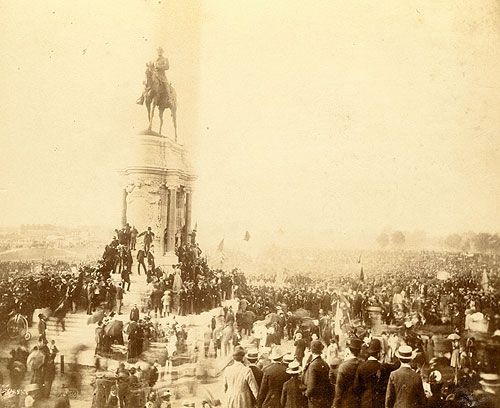
Mary Anna Randolph Custis Lee with son Robert E. Lee, Jr.

Robert E. Lee in his Confederate Army uniform
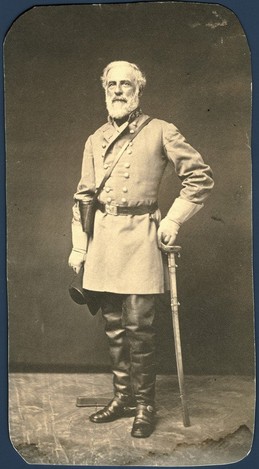
Robert E. Lee circa 1851
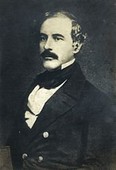
Robert E. Lee circa 1838
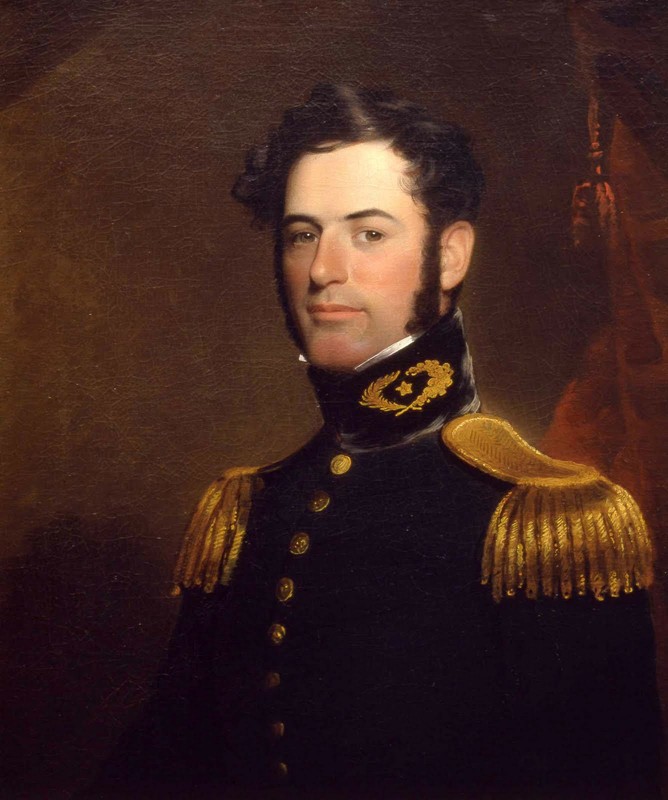
Robert E. Lee and son William Henry Fitzhugh "Rooney" Lee
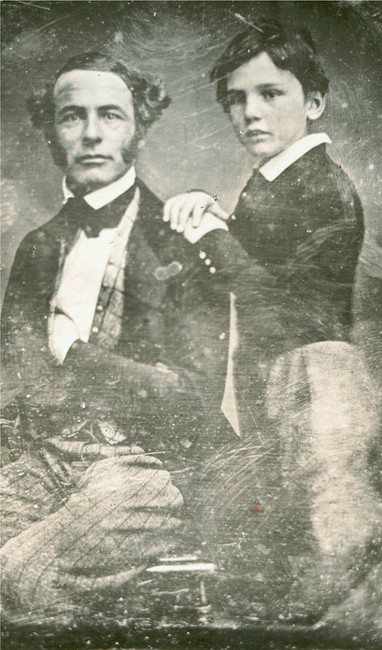
Backstory and Context
Text-to-speech Audio
The son of Virginia Governor and American Revolutionary General Henry “Light-Horse Harry” Lee III and Anne Hill Carter, General Robert Edward Lee came from the prominent Lee family, one of the First Families of Virginia, the elite and socially prominent families who settled Eastern Virginia. Born circa 1807, Robert endured a tumultuous childhood with the financial ruin and eventual abandonment by his father. Between 1825-1829, Robert attended and graduated from West Point Military Academy. He entered the Corps of Engineers and served with distinction during the Mexican American War. Following the conflict, he served as superintendent of West Point and eventually rose to second-in-command for the 2nd Cavalry Regiment in Texas.
In 1831, Robert married Mary Anna Randolph Custis, the great-granddaughter of Martha Washington and her first husband Daniel Park Custis. Together, Robert and Mary had seven children. In 1857, Robert and Mary inherited the Arlington House plantation from her father George Washington Parke Custis. Arlington House sits atop a hill overlooking the Potomac River and Washington, D.C. (presently the site of Arlington National Cemetery). Lee’s subsequently poor treatment of the Custis slaves broke with the Washington family tradition of respecting and preserving slave families, which is indicative of the increasingly cruel conditions slaves lived under towards the middle of the 19th-century.
Between 1859-1861, Lee became involved in two crucial events that led to the Civil War: John Brown’s raid on Harpers Ferry and the secession of Texas from the Union. Being stationed in Texas when it seceded, Lee initially remained in the United States Army. But when President Abraham Lincoln asked Lee to lead the Union army, he declined the offer, citing loyalty to his "home country," which antebellum Americans would understand as a statement of loyalty to Virginia and Southern culture. In 1861, Lee accepted appointment as a general within the Confederate Army.
Although Robert E. Lee’s Confederate military career began somewhat inauspiciously during its early campaigns in Western Virginia, Lee rose to acclaim during the summer of 1862 in his defense of Richmond. He led the Confederate Army of Northern Virginia for the remainder of the Civil War, winning a significant number of major engagements and garnering a reputation as a skilled tactician and logistician. Yet Lee and Confederate leaders could not identify a successful military strategy, and as the war wore on, Confederate armies struggled in the field. On April 8, 1865, Lee surrendered the Army of Northern Virginia to Union General Ulysses S. Grant at Appomattox Courthouse in Virginia, a clear sign that the Confederacy was folding.
After the war, Lee became president of Washington College (now Washington and Lee) in Lexington, Virginia where he remained until his passing in 1870. Shortly after his death, two groups formed in Richmond, one of Confederate veterans and the other of prominent women, each aiming to erect its own monument to Lee in the city. Throughout the next decade, the two groups continued to raise funds alongside each other, but eventually became one unified group in 1886 by Virginia Governor Fitzhugh Lee, nephew of Robert E. Lee. The Lee Monument Association, as it came to be known, sought to replicate an image of Lee astride his horse Traveller from the painting by Adalbert Volck. A year later, Richmond decided on a parcel on land owned by the Allen family on which to place the Lee monument. Located to the west of the city, the monument location opened up new real estate opportunities on that side of Richmond. In 1887, the Association finally commissioned French sculptor Antonin Mercie for the job. It took Mercie three years to complete the statue.
In October 1887, thousands of Richmond residents gathered at the Allen property to witness the laying of the cornerstone for the General Robert E. Lee monument. Colonel Charles Marshall, Lee’s wartime staff officer, delivered the keynote speech during which he asked “What mean ye by this monument to an enemy of the Union which you teach us to cherish and defend?” Marshall continued with an explanation that Lee was actually a defender of the Union and the constitutional freedoms it provided before President Lincoln destroyed it. This perception of Lee as a savior of American freedom spread throughout white America and continues to exist into the present-day.
Mercie’s statue finally arrived from France on May 7, 1890 packaged in four separate crates. A crowd between 10,000 and 20,000 Richmonders helped haul the crates from the James River to the cornerstone on the Allen property. Constructed by African American laborers, ironically enough, the General Robert E. Lee Monument was officially unveiled on May 29 to a crowd estimated to be between 100,000 and 150,000. Col Archer Anderson, former Confederate military officer, delivered the keynote speech for this 61-foot-tall monument. Anderson contributed to the growing trend of idolizing the Confederacy and spreading the Lost Cause ideology by praising Lee as a man of action and a hero of his home state of Virginia. Anderson created an image of Lee that became a venerable and respectable representation of the American archetype of honor. While there were some negative media reactions to the General Robert E. Lee Monument, most were positive or neutral. The proliferation of the Lost Cause ideology had already taken root across the majority of white America.
However, not everyone agreed with the decision to honor Lee or were willing to entertain any justification behind such a monument. Several of Richmond’s city councilmen were African American and these men refused to vote for monument funds or support the initiative. John Mitchell, Jr. was one of the African American councilmen and editor for the Richmond Planet is quoted in the book Richmond’s Monument Avenue as saying,
The men who talk most about the valor of Lee and the blood the brave Confederate dead are those who never smelt powder or engaged in battle. Most of them were at a table, either on top or under it when then war was going on… The capital of the late Confederacy has been decorated with emblems of the ‘Lost Cause,’ he editorialized, and the placement of the Lee statue handed down a ‘legacy of treason and blood’ to future generations. In another editorial Mitchell noted, “He [the African American] put up the Lee Monument, and should the time come, will be there to take it down.[2]
It would be another ten years before Richmond erected another Confederate monument. But in those ten years, the Lee monument became the unofficial center of Richmond. Between 1904 and 1930, five more Confederate monuments were placed along what came to be known as Monument Avenue. City planners utilized principles from the City Beautiful movement and Beaux Arts to create a grand, residential neighborhood surrounding this Confederate thoroughfare. Today, Monument Avenue is the nation’s only surviving grand, residential boulevard with monuments of its scale remaining largely unaltered. For that reason, the Monument Avenue Historic District was designated a Virginia Landmark on December 2, 1969, added to the National Register of Historic Places on February 16, 1970, and designated a National Historic Landmark on December 3, 1997.
Though some Confederate monuments were erected immediately following the American Civil War, there was a sharp increase in public art dedicated to the Confederacy in the late-19th and early-20th Centuries, particularly in the South. During this time, states were enacting oppressive, segregationist Jim Crow laws while the Ku Klux Klan (formed immediately after the Civil War) revived dramatically. Using these examples from history, many historians demonstrate that these Jim Crow Era monuments were not only intended to honor Confederate leaders and veterans but were calculated to promote white supremacy in American society by public intimidation. Richmond, in particular, experienced an explosion of Confederate monuments during this time. Historian William Cooper, Jr. explained that Richmond was not only the former capital of the Confederacy but also "the capital of its memory."[11]
Reflecting the ways that historical interpretations change over time, many Southerners who reject the Lost Cause ideology and hope to create a more pluralistic society view Confederate monuments with great concern. From their perspective, the speeches given at dedication ceremonies by leaders of what had become a white-only Southern Democratic Party, as well as explicitly racist comments by Lee and other Confederate leaders during and after the war, provide evidence of their concerns. Since the erection of the General Robert E. Lee Monument and the subsequent development of Monument Avenue, controversy has continued to surround the city’s decision to honor the Confederacy and its racist history supported by the Lost Cause ideology. In July 2017 a ten-member Monument Avenue Commission recommended adding permanent signage at every monument to offer modern and more inclusive interpretations of the sites.
Yet controversy over the Lee Monument continued. Following the death of Black man George Floyd and nationwide protests over systemic racism in 2020, Confederate monuments again came under scrutiny. The Lee Monument was vandalized with graffiti, but many in Richmond's community came to see the graffiti differently. As local Richmond artist Gregory Carden noted, "For some people it looks like destruction; to me it looks like art."[14]
In June 2020, Virginia Governor Ralph Northam ordered the monument to be removed. Richmond Mayor Levar Stoney supported the move, stating: "Richmond is no longer the capital of the Confederacy — it is filled with diversity and love for all — and we need to demonstrate that."[12] As the Lee Monument was slated for removal, other Confederate statues along Richmond's Monument Avenue were removed, including those of Jefferson Davis, J.E.B. Stuart, and Matthew Fontaine Maury. The decision to remove the Lee Monument was contested by nearby residents, but in October 2020 a judge upheld the state's right to remove the statue. Although the state won the case, an appeals process stayed the Lee Monument's removal for the moment. The Virginia Supreme Court dismissed the appeal, and the twelve-ton bronze statue was removed in September 2021 [15]. The graffiti-covered pedestal base also was removed later.
Sources
1. Griego, Tina. Past and Present: The Many-Sided History of the Monument Avenue Debate. Richmond Magazine. June 25, 2015. June 3, 2019. https://richmondmagazine.com/news/news/monument-ave-history/.
2. Driggs, Sarah Shields; Richard Guy Wilson; Robert P. Winthrop (2001). Richmond's Monument Avenue. Chapel Hill, North Carolina: University of North Carolina Press.
3. Southern Poverty Law Center. "Whose Heritage? Public Symbols of the Confederacy." 2017. Accessed August 20, 2017. https://www.splcenter.org/sites/default/files/whoseheritage_splc.pdf.
4. The Washington Post. "The Day White Virginia Stopped Admiring Gen. Robert E. Lee and Started Worshiping Him." Accessed 13 September 2017. https://www.washingtonpost.com/news/retropolis/wp/2017/08/22/the-day-white-Virginia-stopped-admiring...
5. Levin, Kevin M. What Richmond Has Gotten Right About Interpreting Its Confederate History." Smithsonian Magazine. May 18, 2017. June 3, 2019. https://www.smithsonianmag.com/history/what-richmond-has-gotten-right-about-interpreting-its-Confederate-history-180963354/.
6. Monument Avenue Historic District. National Park Service. June 3, 2019. https://www.nps.gov/nr/travel/richmond/monumentavehd.html.
7. 127-0174 Monument Avenue Historic District. Virginia Department of Historic Resources. April 1, 2019. June 3, 2019. https://www.dhr.virginia.gov/historic-registers/127-0174/.
8. On Monument Avenue | "What Mean Ye By This Monument?". The American Civil War Museum. June 3, 2019. https://acwm.org/blog/monument-avenue-what-mean-ye-monument.
9. Blog. On Monument Avenue. June 6, 2019. https://onmonumentave.com.
10. Monument Avenue Commission Report. Monument Avenue Commission. July 2, 2018. June 6, 2019. https://static1.squarespace.com/static/594bdfc3ff7c502289dd13b3/t/5b3a821788251b63fef735f7/1530561059506/MonumentAvenueCommissionFINAL.pdf.
11. Cooper, William Jr. Jefferson Davis and the Civil War Era. Baton Rouge: Louisiana State University Press, 2008.
12. Bogel-Burroughs, Nicholas. "Virginia Governor Plans to Order Robert E. Lee Statue Removed." June 3, 2020. New York Times. Web. Accessed November 4, 2020. https://www.nytimes.com/2020/06/03/us/robert-e-lee-statue-richmond.html
13. Paybarah, Azi. "Virginia Governor Can Remove Robert E. Lee Statue, but Not Yet, Judge Rules." October 28, 2020. New York Times. Web. Accessed November 4, 2020. https://www.nytimes.com/2020/10/28/us/lee-statue-richmond-virginia.html
14. McCammon, Sarah. "In Richmond, Va., Protesters Transform a Confederate Statue." June 12, 2020. NPR. Web. Accessed November 4, 2020. https://www.npr.org/2020/06/12/876124924/in-richmond-va-protestors-transform-a-confederate-statue
15 Evans, Whittney. Streever, David. Virginia's Massive Robert E. Lee Statue has been Removed, National Public Radio. September 8th, 2021. Accessed March 25th, 2024. https://www.npr.org/2021/09/08/1035004639/virginia-ready-to-remove-massive-robert-e-lee-statue-following-a-year-of-lawsuit
